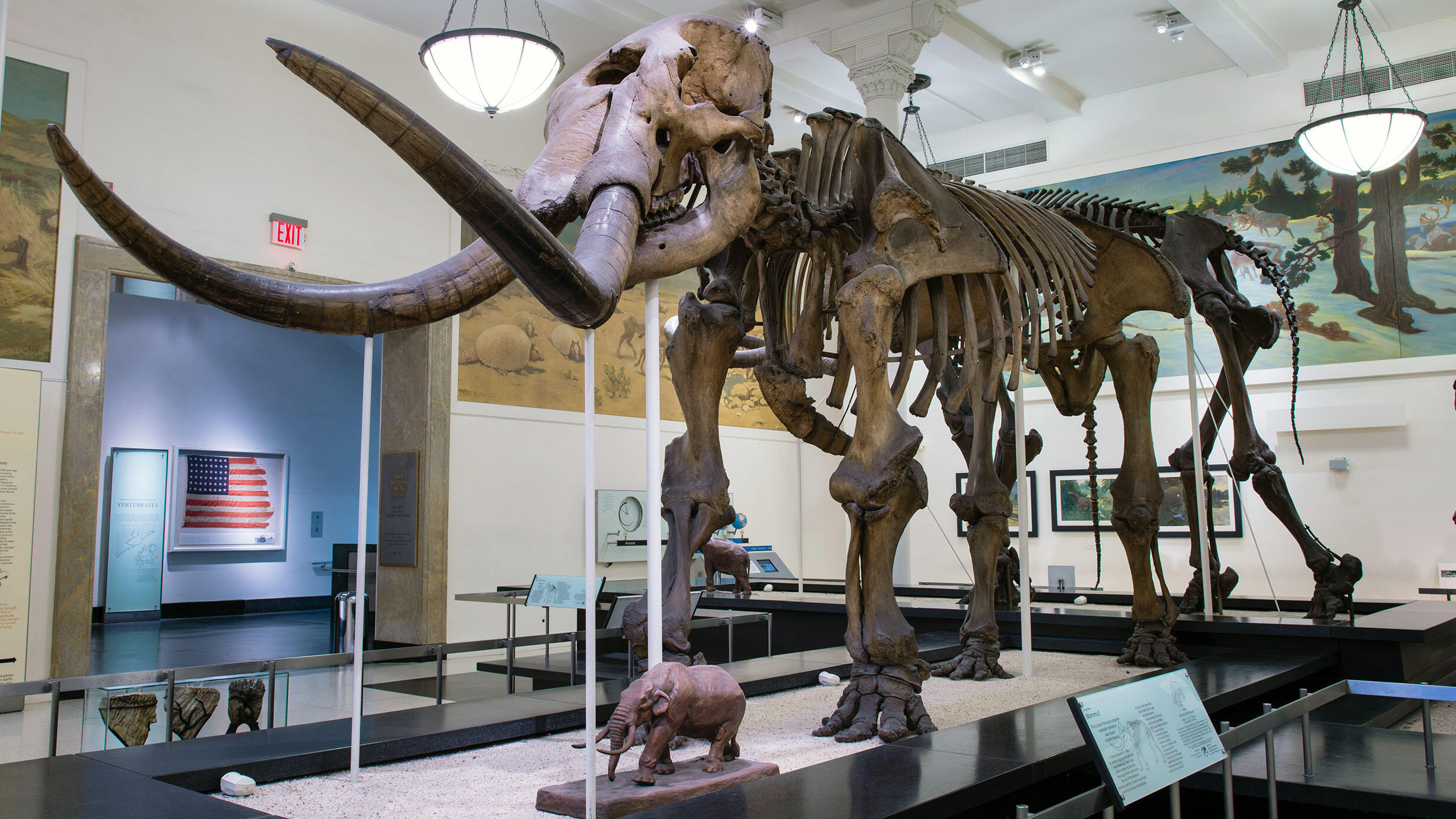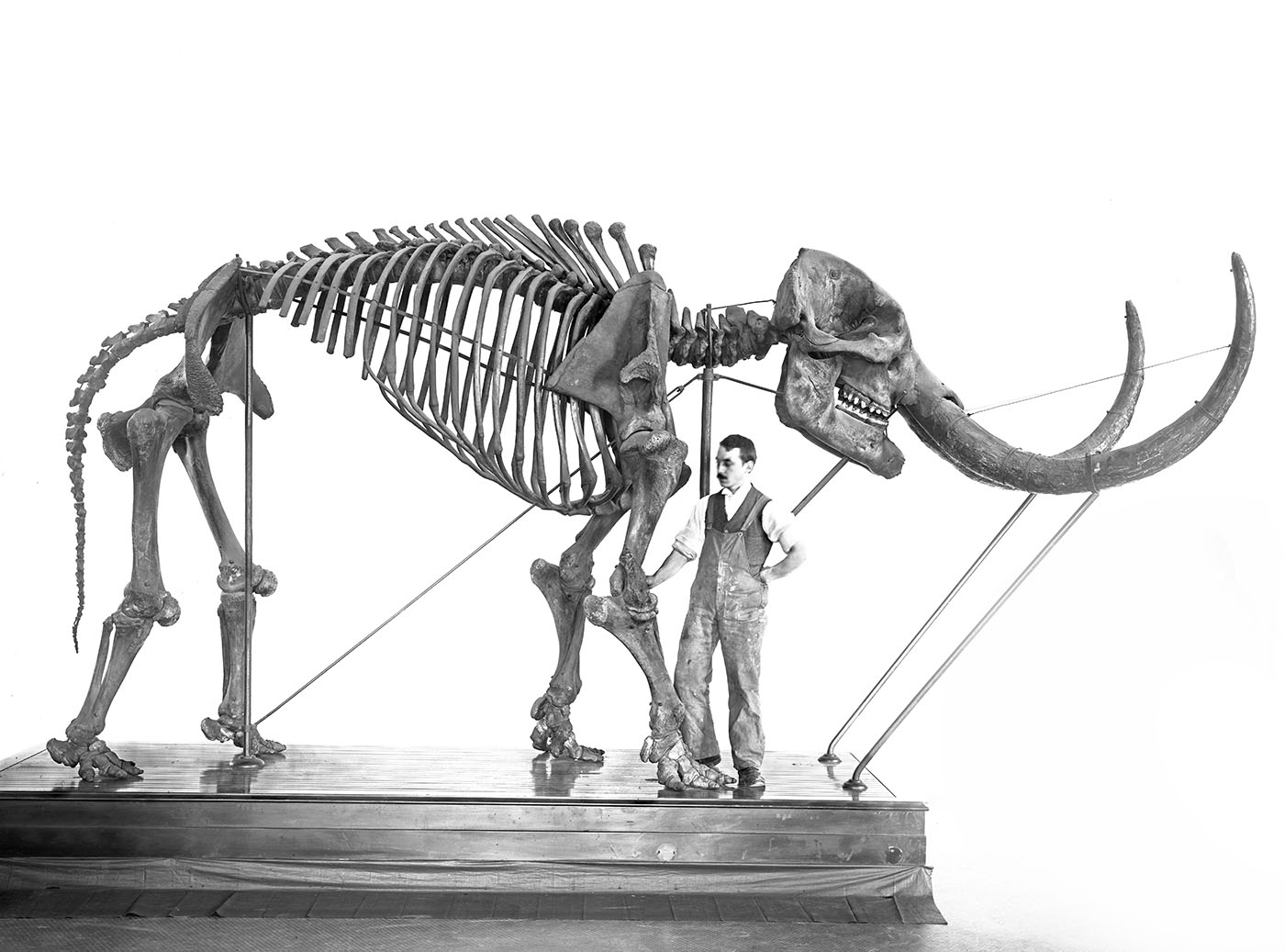Warren Mastodon
Part of Hall of Advanced Mammals.
 D. Finnin/© AMNH
D. Finnin/© AMNH The Warren mastodon bears a strong resemblance to its neighbor in the Paul and Irma Milstein Hall of Advanced Mammals, the mammoth. In fact, these distant cousins of modern elephants parted ways on the evolutionary tree of life about 25 million years ago.
Learn how to tell a mammoth from a mastodon.
Named for John C. Warren, the founder of a Boston-based museum where it was first displayed, the Warren mastodon fossil was discovered in a bog in Newburgh, New York, in 1845. It was the first complete American mastodon (Mammut americanum) skeleton found in the United States and remarkable for being preserved in the position in which it had died some 11,000 years ago: standing upright with its legs thrust forward and its head tilted upward, likely gasping for air under mud in which it had become mired.
The Annotated Warren Mastodon
The Warren mastodon remains one of the most complete mastodon skeletons ever found. The fossil was missing only a few toes and tail bones when it was first exhumed. But when it went on view in 1849, its tusks, which began to disintegrate shortly after excavation, were replaced by 11-foot-long papier-mâché tusks for the display. After it was acquired by the American Museum of Natural History in 1906, the preserved tusk fragments came to New York, where preparators were able to piece them together and determine the correct length: 8 feet 6 inches.
Click on the + signs below to find out more about the Museum’s Warren mastodon fossil.
Captured in Time
This fossil skeleton of an American mastodon (Mammut americanum) was discovered in 1845 on a farm near Newburgh, New York. Based on its position, this distant cousin of the elephant became mired in mud some 11,000 years ago and died while struggling to extricate itself. Most of the skeleton was embedded in a 3-foot layer of shell marl—a lakebed sediment of mostly mollusk shells—beneath a foot of red moss and 2 feet of peat, which protected the bones from decomposition and scavengers for millennia. Lacking only a few toe bones and tail vertebrae, the skeleton is exceptional for being so nearly complete.
Imitation Tusks
In 1849, the Warren mastodon was mounted for display at the private Warren Museum of Natural History in Boston, where it remained until it was acquired by the American Museum of Natural History in 1906. The mastodon’s tusks began to disintegrate immediately after excavation, so to prevent further damage, the Warren Museum’s founder, surgeon and anatomist John C. Warren, supervised the sawing off of about 3 feet of the tusks. Papier-mâché tusks were created for the display, measuring slightly too long at 11 feet.
Clean Slate
Before going on display at the Museum, the skeleton required an intense cleaning because the mastodon had been covered with a thick coat of black varnish. The bones were immersed in large vats of pure benzine for weeks and then vigorously scrubbed with pure spirits of alcohol. According to a contemporary account, “One by one the bones emerged from this prolonged and very expensive bath in all the purity of color that characterized the skeleton when it was exhumed.”
Delicate Detective Work
The preserved tusk fragments accompanied the mastodon to New York, where Museum preparators discovered a splinter of tusk that helped piece the full tusks together. “There was great rejoicing in the lab … because it enabled us to determine positively the length of the tusks as 8 feet 6 inches,” according to an account in a Museum publication. Having the correct dimensions helped to solve two other puzzles: the exact position of the tusks within their sockets, and the approximate age of the mastodon at death—about 30 years, based on the now-clarified growth rings.
Enduring Evidence
Nearly two centuries after its discovery, the Warren mastodon is still contributing to science. In a 2006 paper, co-author and Museum Research Associate Matthew C. Mihlbachler used a detailed description of a column of intestinal contents—digested branches and twigs—found under the Warren mastodon’s pelvis in 1845 to help identify fossilized mastodon dung at a dig site in Florida. A small tin of these remains of the mastodon’s “last meal” is in the Museum’s Fossil Mammal Collection.
